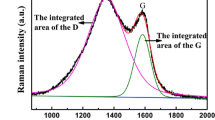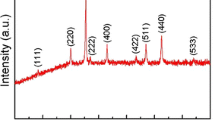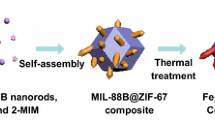Abstract
Due to their high theoretical capacities and high energy densities, metal fluorides have attracted significant attention as cathodes for lithium-ion batteries. However, thus far, their low conductivities have limited the performance of these materials. In this work, the Fe(1−x)Co x F3/MWCNT (multi-walled carbon nanotube) nanocomposites (x = 0, 0.02, 0.04 and 0.06) are obtained by an in situ solvothermal method with Co-doping and wrapping of the MWCNTs. The results indicate that Co-doping can adjust the crystal structure, decrease the band gaps and enhance the Li+ diffusion coefficient of FeF3. Additionally, the wrapped network of MWCNTs enhances the conductivity of the composites and improves their electrochemical performances. The Fe0.96Co0.04F3/MWCNT nanocomposites exhibit a high initial discharge capacity of 217.0 mAh g−1 at rate of 0.2 C within the potential range of 2.0–4.5 V, which is much higher than that of the FeF3/MWCNT counterpart (192.1 mAh g−1). The discharge capacities of these two samples remain at 187.9 and 160.7 mAh g−1 even after 50 cycles. Meanwhile, the EIS results reveal that both the Li+ charge transfer resistance (R ct = 31.25 Ω) and Li+ diffusion coefficient (1.40 × 10−11 cm2 s−1) are satisfactory from Co-doping and the in situ wrapping of the MWCNTs.








Similar content being viewed by others
References
Bruce PG (2008) Energy storage beyond the horizon: rechargeable lithium batteries. Solid State Ion 179:752–760
Armand M, Tarascon JM (2008) Building better batteries. Nature 451:652–657
Li H, Balaya P, Maier J (2004) Li-storage via heterogeneous reaction in selected binary metal fluorides and oxides. J Electrochem Soc 151:A1878–A1885
Zhou MJ, Zhao LW, Okada S, Yamaki JI (2011) Thermal characteristics of a FeF3 cathode via conversion reaction in comparison with LiFePO4. J Power Sources 196:8110–8115
Li L, Meng F, Jin S (2012) High-capacity lithium-ion battery conversion cathodes based on iron fluoride nanowires and insights into the conversion mechanism. Nano Lett 12:6030–6037
Jiang J, Li LP, Xu MW, Zhu JH, Ming C (2016) FeF3@thin nickel ammine nitrate matrix: smart configurations and applications as superior cathodes for Li-ion batteries. ACS Appl Mater Interfaces 8:16240–16247
Ma R, Lu Z, Wang C, Wang H, Yang S, Xi L, Chung J (2013) Large-scale fabrication of graphene-wrapped FeF3 nanocrystals as cathode materials for lithium ion batteries. Nanoscale 5:6338–6343
Li CL, Gu L, Tong JW, Tsukimoto S (2011) A mesoporous iron-based fluoride cathode of tunnel structure for rechargeable lithium batteries. Adv Funct Mater 21:1391–1397
Jangwook L, Byoungwoo K (2016) Novel and scalable solid-state synthesis of a nanocrystalline FeF3/C composite and its excellent electrochemical performance. Chem Commun 52:9414–9417
Li CL, Gu L, Tong JW, Maier J (2011) Carbon nanotu be wiring of electrodes for high-rate lithium batteries using an imidazolium-based ionic liquid precursor as dispersant and binder: a case study on iron fluoride nanoparticles. ACS Nano 5:2930–2938
Ma DL, Wang HG, Li Y, Xu D, Yuan S, Huang XL, Zhang XB, Zhang Y (2014) In situ generated FeF3 in homogeneous iron matrix toward high-performance cathode material for sodium-ion batteries. Nano Energy 10:295–304
Chu QX, Xing ZC, Ren XB, Asiri AM, Al-youbi AO, Alamry KA, Sun XP (2013) Reduced graphene oxide decorated with FeF3 nanoparticles: facile synthesis and application as a high capacity cathode material for rechargeable lithium batteries. Electrochim Acta 111:80–85
Wu W, Wang Y, Wang XY, Chen QQ, Wang X, Yang SY, Liu XM (2009) Structure and electrochemical performance of FeF3/V2O5 composite cathode material for lithium-ion battery. J Alloy Compd 486:93–96
Xu XP, Chen S, Shui M, Xu LX, Zheng WD, Shu J, Cheng LL, Feng L, Ren YL (2014) One step solid state synthesis of FeF3·0.33H2O/C nano-composite as cathode material for lithium-ion batteries. Ceram Int 40:3145–3148
Fan LH, Li BJ, Zhang NQ, Sun KN (2015) Carbon nanohorns carried iron fluoride nanocomposite with ultrahigh rate lithium ion storage properties. Sci Rep 5:12154–12162
Li CL, Yin CL, Gu L, Dinnebier RE (2013) An FeF3·0.5H2O polytype: a microporous framework compound with intersecting tunnels for Li and Na batteries. J Am Chem Soc 135:11425–11428
Li H, Richter G, Maier J (2003) Reversible formation and decomposition of LiF clusters using transition metal fluorides as precursors and their application in rechargeable Li batteries. Adv Mater 15:736–739
Bai Y, Zhou XZ, Jia Z, Wu C, Yang LW, Chen MZ, Zhao H, Wu F, Liu G (2015) Understanding the combine effects of microcrystal growth and band gap reduction for Fe(1-x)Ti x F3 nanocomposites as cathode materials for lithium-ion batteries. Nano Energy 17:140–151
Liu L, Zhou M, Yi LH, Guo HP, Tan JL, Shu HB, Yang XK, Yang ZH, Wang XY (2012) Excellent cycle performance of Co-doped FeF3/C nanocomposite cathode material for lithium-ion batteries. J Mater Chem 22:17539–17550
Yang ZH, Pei Y, Wang XY, Liu L, Su X (2012) First principles study on the structural, magnetic and electronic properties of Co-doped FeF3. Comput Theor Chem 1:44–48
Jung H, Shin J, Chae CJK, Lee J Lim (2013) FeF3/ordered mesoporous carbon (OMC) nanocomposites for lithium ion batteries with enhanced electrochemical performance. J Phys Chem C 117:14939–14946
An HF, Wang Y, Wang XY, Zheng LP, Wang XY, Yi LH, Bai L, Zhang XY (2010) Polypyrrole/carbon aerogel composite materials for supercapacitor. J Power Sources 195:6964–6969
Cho J, Kim H, Park B (2004) Comparison of overcharge behavior of AlPO4-coated LiCoO2 and LiNi0.8Co0.1Mn0.1O2 cathode materials in Li-ion cells. J Electrochem Soc 151:A1707–A1711
Wei SY, Wang XY, Zhang R, Hu H, Shen YQ, Liu J (2016) Preparation and performance of spherical FeF2.5·0.5H2O nanoparticles wrapped by MWCNTs as cathode material of lithium ion batteries. RSC Adv 6:97759–97769
Lu Y, Wen ZY, Jin J, Rui K, Wu XW (2014) Hierarchical mesoporous iron-based fluoride with partially hollow structure: facile preparation and high performance as cathode material for rechargeable lithium ion batteries. Phys Chem Chem Phys 16:8556–8562
Fukushima T, Kosaka A, Ishimura Y, Yamamoto T, Takigawa T, Ishii N, Aida T (2003) Molecular ordering of organic molten salts triggered by single-walled carbon nanotube. Science 300:2072–2074
Gao F, Tang ZY (2008) Kinetic behavior of LiFePO4/C cathode material for lithium-ion batteries. Electrochim Acta 53:5071–5075
Wang XY, Hao H, Liu JL, Huang T, Yu AS (2011) A novel method for preparation of macroposous lithium nickel manganese oxygen as cathode material for lithium ion batteries. Electrochim Acta 56:4065–4069
Acknowledgements
This work is supported by Science and Technology Plan Foundation of Guangdong (2015A050502046) and Science and Technology Plan Foundation of Guangzhou (201704030031).
Author information
Authors and Affiliations
Corresponding author
Rights and permissions
About this article
Cite this article
Li, J., Xu, S., Huang, S. et al. In situ synthesis of Fe(1−x)Co x F3/MWCNT nanocomposites with excellent electrochemical performance for lithium-ion batteries. J Mater Sci 53, 2697–2708 (2018). https://doi.org/10.1007/s10853-017-1685-2
Received:
Accepted:
Published:
Issue Date:
DOI: https://doi.org/10.1007/s10853-017-1685-2




